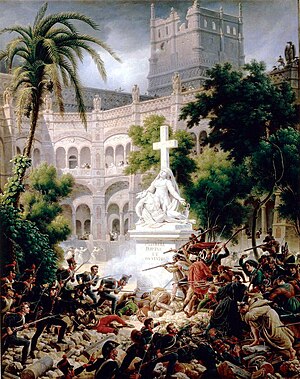Siege of Zaragoza (1809)
| date | December 20, 1808 to February 20, 1809 |
|---|---|
| place | Zaragoza , Spain |
| output | French victory |
| Parties to the conflict | |
|---|---|
| Commander | |
|
Edouard Adolphe Mortier |
|
| Troop strength | |
| 40,000 soldiers, 60 cannons | 34,000 regulars, an unknown number of armed citizens |
| losses | |
|
10,000 dead |
24,000 dead soldiers and 30,000 dead civilians |
Bailén - Roliça - Vimeiro - Saragossa (1808) - Burgos (Gamonal) - Medina de Rioseco - Espinosa - Tudela - Somosierra - Saragossa (1809) - La Coruña - Torres Vedras - Valls - Braga - Oporto - Talavera - Ocaña - Gerona - Ciudad Rodrigo (1810) - Buçaco - Gévora - Barrosa - Badajoz (1811) - Fuentes de Oñoro - La Albuera - Tarragona (1811) - Sagunto (Murviedro) - Ciudad Rodrigo (1812) - Badajoz (1812) - Majadahonda - Salamanca - García Hernández - Venta del Pozo - Vitoria - Sorauren - San Sebastián - Bidassoa
The siege of Zaragoza took place on the Iberian Peninsula during the Napoleonic Wars and was the second by the French in that war, after having tried unsuccessfully from June to August 1808 .
First attack
On June 25, 1808, General Verdier took command of the French siege army assembled in front of Saragossa, which initiated the bombardment on July 1. On July 11th, the French began to build a bridge over the Ebro in order to be able to enclose Saragossa from the other side of the river. After being wounded on August 4th, Verdier had to hand over command to General Lefebvre-Desnouettes . On August 4, the French penetrated the city through a breach, but were driven out by Colonel Palafox. On August 13, the French troops in Catalonia had to break off their first two-month siege of Zaragoza without success.
Second attack
The French began new operations against Zaragoza on December 21, 1808. After the French suffered a defeat in their first siege of the city, new trenches were dug in front of the city , walls were raised and the monasteries in front of the city were fortified. General José de Palafox y Melci had 34,000, mostly inexperienced, men available in the city and could count on armed support from civilians.
Marshals Bon-Adrien-Jeannot de Moncey and Édouard Adolphe Mortier had 40,000 soldiers and 60 heavy artillery at their disposal for the siege.
Before the end of the year, the French troops had built a siege ring around the city and a pontoon bridge over the Ebro . On the Spanish side, Palafox's decision to assemble so many troops in the city had meant that the French could not be disturbed by attacks from outside the city. In addition, many farmers had fled to the city, and typhus broke out because of the high concentration of people and animals . Soon a third of the defense attorneys fell ill.
The bombing of Zaragoza began on January 10, 1809. After two weeks of bombardment, several breaches had been made in the fortifications, and so the newly arrived Marshal Jean Lannes ordered the storming of the city on January 27th. The French encountered strong resistance. They had only managed to penetrate a little way into the city through one breach . The French fought their way through tough house-to-house and mine warfare . Over three weeks after the fighting began in Saragossa, the Spaniards, weakened by hunger, typhus and shelling, surrendered on February 20, 1809.
The Spaniards lost 54,000 people, including 30,000 civilians, while the French lost 10,000 men.
The siege did not have a major impact on the course of the war, but it did bring propaganda success for the Spaniards. The British found it difficult to withdraw from the fighting.
gallery
reception
The dramaturge Benito Pérez Galdós published his novel "Zaragoza" from 1873-1875, which is set during the second siege of the city. The 1000 peseta notes produced between 1982 and 1991 bore his portrait and to the right of it was a passage from the novel: “... and between all the dead a living voice will still rise to say that Zaragoza is itself does not result. "
On the French side, the painter Baron Louis-François Lejeune described his experiences during the 2nd siege of the city, in which he participated as a colonel.
Individual evidence
- ^ Esdaile, Charles: The Peninsular War. A New History. London 2002, p. 159
- ^ Esdaile, Charles: The Peninsular War. A New History. London 2002. p. 161.
- ^ Esdaile, Charles: The Peninsular War. A New History. London 2002, p. 163.
- ↑ Los sitios de Zaragoza según la narración del oficial sitiador, baron Lejeune. Zaragoza, M. Escar, 1908
literature
- Charles Esdaile: The Peninsular War. A New History. Penguin Books, London et al. 2002, ISBN 0-14-027370-0 .
- Frank Bauer: Saragossa 1808–1809. Edition König und Vaterland, Potsdam 2010 ( Small series History of the Wars of Liberation 1813–1815. H. 32, ZDB -ID 2599930-8 ).
Web links
- Cultural Association "Los Sitios de Zaragoza" (Spanish)
- History of the Sieges of Saragossa 1808-1809 (Spanish)
- The Sieges of Zaragoza (Spanish)






